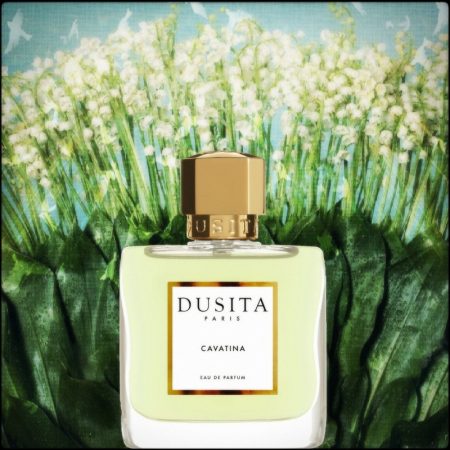
Parfums Dusita Cavatina (fragrance visualisation by Despina Veneti©)
“Le Temps du Muguet ne dure jamais
plus longtemps que le mois de mai
Quand tous ses bouquets déjà seront fanés
pour nous deux, rien n’aura changé
Aussi belle qu’avant
notre chanson d’amour
chantera comme au premier jour”
“The Season of Muguet never lasts
longer than the month of May
But even when all bouquets fade
for us, nothing will change
Just as beautiful as ever
our love song
will be singing like on its very first day.” (“Le Temps Du Muguet” lyrics by Francis Lemarque / Translation by Despina Veneti)
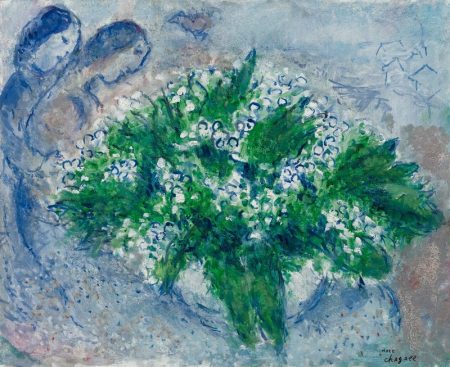
Le Muguet by Marc Chagall©, c. 1975
With his beautiful lyrics for the song “Le Temps du Muguet”, poet/songwriter/singer Francis Lemarque eulogized the transcending, time-defying power of love – the kind of love that can hold captive even the freshness of the most fleeting of springtime flowers: the lily of the valley. An emblematic flower for the French, Muguet symbolises purity, joy, discretion, honesty and happiness, and has been for centuries considered a scented porte-bonheur. Spring is difficult and lonely this year in pandemic-stricken Europe, and in France many of us might not be able to offer a brin de muguet to our loved ones on May 1st. The luminous, gracious, muguet of Parfums Dusita Cavatina couldn’t have come at a more opportune moment.
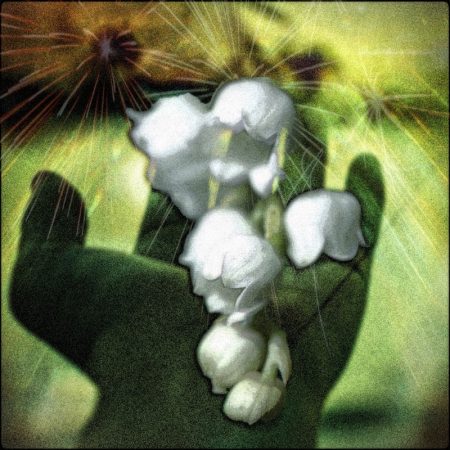
Muguet captured (photo composition/digital editing by Despina Veneti©)
Regarding perfumery, lily of the valley has been famously elusive: resisting all known methods of extraction/distillation, the little bell-shaped flowers seem determined to withhold their aromatic essence (only tiny quantities of oil can be extracted, just enough for chemical analysis). The muguet note, therefore, is reconstructed using other materials, and is largely subject to each perfumer’s personal interpretation. An added difficulty to the quest for a genuine lily of the valley note is the fact that – unlike other florals (rose, jasmine, violet or iris) – the flower’s analysis did not reveal the existence of a signature ingredient. Fortunately, chemistry and technology came to the perfumers’ aid: the synthetic ingredient hydroxycitronellal was discovered in the beginning of the 20th century, followed by Givaudan’s discovery of cyclamen aldehyde – both leading to several commercialised lily of the valley bases (such as DeLaire’s Mayciane); from the 1950s onwards, the development of a series of certain aldehydes helped perfumers achieve successful muguet reconstructions (Lilial and Bourgeonal by Givaudan, Lyral by IFF, etc). After the severe IFRA restrictions on all the above, a whole new generation of environmentally and toxicologically safer muguet compounds has emerged, including Givaudan’s Nympheal and Mahonial, and Firmenich’s Tillenal, Josenol, and Lilyflore. What remains timelessly instrumental to a superior lily of the valley reconstruction is the perfumer’s technical ability and artistic sensibility.
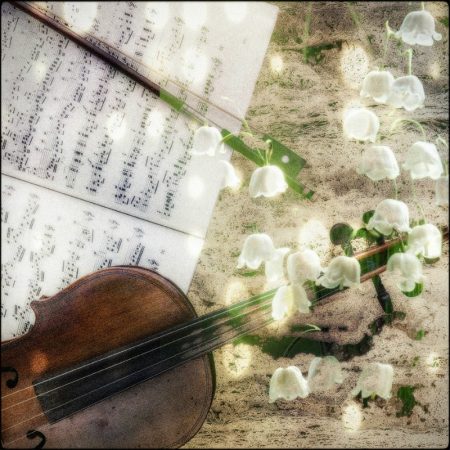
Muguet melody (photo composition/digital editing by Despina Veneti©)
Photorealism may be technically admirable, but not necessarily desired in artistic creation; the latter, after all, is based on choice, point of view, subjectivity. Thus, I find that each of my preferred muguet-centered fragrances has approached its characteristic main floral note in different ways: Edmond Roudnitska composed a remarkably realistic lily of the valley for Dior Diorissimo, yet the original scent included a fascinating contrast with civet; in Coty Muguet Des Bois, Henri Robert laid his dewy spring bouquet on a warm base of sandalwood and musk; in Hermès Hermessence Muguet Porcelaine, Jean-Claude Ellena successfully incorporated unexpected melon and animalic tones; and, in Antoine Maisondieu’s Van Cleef & Arpels Muguet Blanc, the lily of the valley is stripped of its green sharpness, given an almost angelic aura. Having worn Parfums Dusita Cavatina for more than a month, I now place it with certainty among the crème de la crème of muguet-centered compositions: apart from being an utter joy to wear, the fragrance is remarkable for both its stellar recreation of the main lily of the valley note, and its long-sustained citrusness that extends to the very base. In addition, it may well be the most gender-fluid muguet scent I have ever smelled.
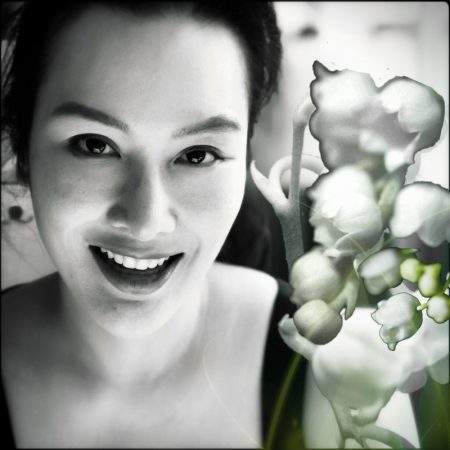
Parfums Dusita founder/perfumer Pissara Umavijani (photo courtesy of Pissara Umavijani, digital effects by Despina Veneti©)
I was fortunate enough to discuss the fragrance in depth with its creator, Parfums Dusita founder and perfumer Pissara Umavijani, while smelling with her all its ingredients. Pissara told me that Cavatina was born out of her wish to honor her beloved, late aunt whose signature scent was Diorissimo, a fragrance which she took her time studying. The talented perfumer was, nevertheless, determined to create a resolutely modern, distinctly unisex lily of the valley fragrance with the “natural appeal of a happy, harmonious melody” (referencing her own love for music, and her violin-playing years). Most interestingly, she didn’t opt for any of the innovative muguet components that emerged during the recent years, constructing her lily of the valley accord with “old school” cyclamen aldehyde – in the tiny amount that is now allowed. To my question how she managed to achieve such a genuine muguet note given the restrictions on the aforementioned material, Pissara answered: “my “secret” was two and a half years of work, and litsea cubeba, a rather underused natural ingredient with a great variety of aromatic properties; it elevates Cavatina’s muguet accord, while giving a huge boost to the citruses”.

Muguet bliss (photo composition/digital editing by Despina Veneti©)
Parfums Dusita Cavatina opens in unmistakable sunshine and bliss: ahead blooms a whole field of smiling muguets in all their green, floral, and slightly soapy glory, surrounded by a radiant halo of juicy bergamot, herbaceous petitgrain, and sparkling litsea cubeba. The latter comes from a tree indigenous to Southeast Asia (where it’s known as “mountain pepper”, and its essence as “oil of tranquility”), and it’s indeed a fascinating ingredient: at once herbal and fruity, it contributes invigorating lemon/verbena tones, and grassy nuances. Pissara told me that she found litsea cubeba to be a great fixative as well, and an ideal link to her muguet accord (the raw material contains citronellol, also a basic component of natural lily of the valley). Technically speaking, the perfumer has composed a fantastically bright, vivacious muguet that is mainly based on natural ingredients (yellow lemon, citronellol, indolic white florals, violet leaf, coriander).
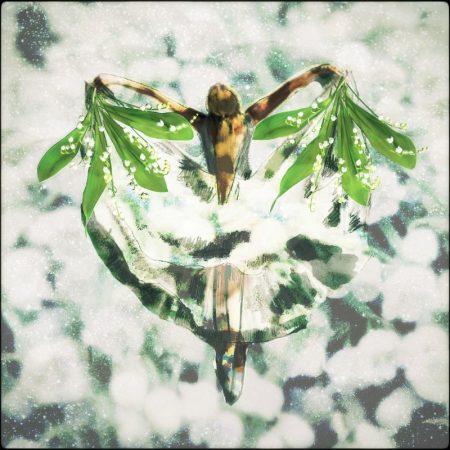
Muguet dance (digital collage/effects by Despina Veneti©, using Pissara Umavijani’s original drawing)
Just like she seamlessly fused citruses and muguet, Pissara Umavijani achieved an equally smooth transition to the scent’s blossoming heart: echoing her muguet accord’s white floral elements, she added extra touches of intoxicating jasmine (both sambac and grandiflorum), green tuberose, and fruity ylang-ylang. The fragrance’s jubilant spring bouquet is further adorned by the perfumer’s own “tea rose accord”, a thing of such beauty that could easily be worn on its own (Damask and May rose blended with cinnamic alcohol, citronellol, and jasmine). The base contains lactonic Australian sandalwood and vanillic nuances, but it’s mainly defined by the vegetal muskiness of ambrette seed, and the unique – resinous, ambery, neroli-like – woodiness of “Bois de Siam” (an essential oil from a coniferous tree that grows in Southeast Asia). Hours after having applied the fragrance on my skin, I could still feel the harmonious muguet melody of Cavatina undiminished as I heard Pissara read the poem of her father, Montri Umavijani: “They sweeten by the warmth of the sun, like the human heart by loving kindness”… “I love the universality of that mysterious “they””, I tell her. “Exactly!”, she responds, “it could refer to flowers and fruits, to you and me, to anyone. It’s this universality that I hoped to achieve with Cavatina”. I can safely say that her hopes have been fulfilled. Parfums Dusita Cavatina is an all-embracing symphony of ebullient citruses, elating florals, and soothing woods. A grand lily of the valley that captures the ephemeral, and embellishes it with everlasting emotion. An evergreen Muguet for all.
Notes: Bergamot (Calabria), Litsea Cubeba (China), Petitgrain (Paraguay), Muguet Accord, Tea Rose Accord, Jasmine (India & Egypt), Tuberose (Egypt), Ylang-Ylang (Indonesia), Siamese Woods (Vietnam), Ambrette Seed (India), Sandalwood (Australia), Vanilla (Madagascar).
Editor’s note: Parfums Dusita Cavatina will be available from April 26, 2021 at the brand’s online shop, and very soon through every Parfums Dusita stockist. The fragrance (EdP) will be available in three sizes: 50ml, 100ml and in travel format (3×7.5ml).
Disclaimer: Many thanks to Pissara Umavijani for my 15ml miniature bottle and illustration of Parfums Dusita Cavatina. The opinions are my own.
– Despina Veneti, Senior Editor
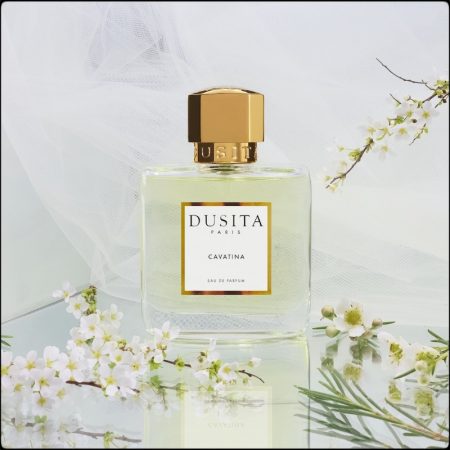
Parfums Dusita Cavatina 50ml bottle (courtesy of Parfums Dusita©)
Thanks to the generosity of Pissara Umavijani and Parfums Dusita, we have a draw for a 50ml avant-première bottle of Parfums Dusita Cavatina (value:150€) for one registered reader in EU, USA and UK. You must register here or your comment will not count. To be eligible, please leave a comment saying what you enjoyed most about Despina’s article, if you have a favorite Parfums Dusita and where you live. Draw closes 4/24/21
Follow us on Instagram: @cafleurebon @despinavnt @parfumsdusita @ploiuma
Please join us in congratulating Senior Editor Despina Veneti, a Perfumed Plume Finalist Instapost 2021. (Despina was the 2019 winner of Perfumed Plume Mainstream/Online/Blog Posting Award for Fragrance Journalism)
This is our Privacy and Draw Rules Policy
We announce the winners only on our site and on our Facebook page, so like Çafleurebon and use our blog feed… or your dream prize will be just spilled perfume…
